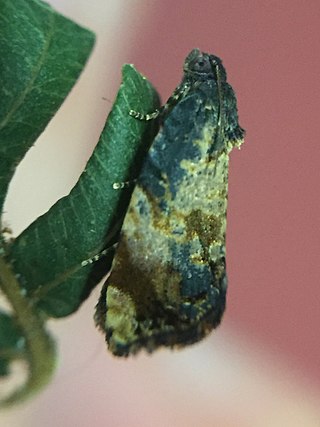
Philocryptica is a monotypic genus of moths belonging to the subfamily Tortricinae of the family Tortricidae. It contains only one species, Philocryptica polypodii, the leather-leaf star-miner, which is endemic to New Zealand. This species has been recorded in both the North Island and the South Island, as far south as Banks Peninsula. The preferred habitat of this species is native forest where the species' larval host is present. The larvae feed on Pyrrosia eleagnifolia, mining the host plant leaves. P. polypodii pupates within the final blotch-mine. Adults are on the wing in November and December.
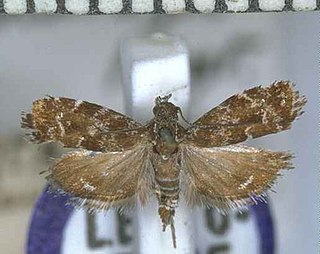
Asterivora analoga is a moth of the family Choreutidae. It is endemic to New Zealand and has been observed in both the North and South Islands. Adults are on the wing in December and January.
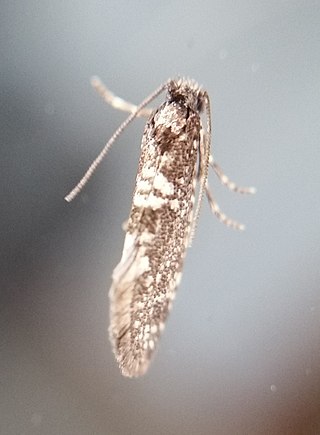
Scoriodyta conisalia is a species of moth in the family Psychidae. It was described by Edward Meyrick in 1888. It is endemic to New Zealand and can be found in the North Island. It has been observed at Karikari, Paihia, in the Poor Knights Islands, and in the Auckland and Wellington regions. The species inhabits native forest and coastal areas where it can be found on rocky outcrops and cliffs. Larvae consume algae and lichens. The adults are on the wing from September to March and are active before sunrise.
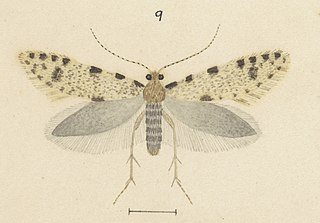
Reductoderces cawthronella is a moth of the Psychidae family. It was described by Alfred Philpott in 1921 and named in honour of the Cawthron Institute. It is endemic to New Zealand and has been collected in Nelson on the Maitai Valley side of the Botanical Hill. The larvae inhabits a fragile, pear shaped case and it has been hypothesised that they are lichen or alga browsers. Larvae pupate at the end of June and adults emerge at the beginning of August until the middle of October.

Charixena iridoxa, also known as the Astelia zig-zag moth, is a moth of the family Plutellidae. It was first described by Edward Meyrick in 1916. This species is endemic to New Zealand and has been observed in the North, South and Stewart Islands. The life cycle of this moth is at least two years in length with the larvae inhabiting the bulb of its host plants and mining the underside of its leaves. These mines have a distinctive zig-zag appearance and can be easily recognised when looked for on the host plants. The larvae pupate in a cocoon attached to the leaf and this stage takes place between February and August. The adult moths emerge in the early spring and are fast, day flying moths. Their larval hosts are plants in the genus Astelia and include Astelia fragrans and Astelia nervosa.

Pyrgotis eudorana is a species of moth of the family Tortricidae. It is endemic in New Zealand and has been observed in both the North and South Islands. However it is regarded as a rare insect. This species inhabits native forest. Larvae exclusively feed on Muehlenbeckia australis and adults are on the wing from November to April. Adults are attracted to light.

Zapyrastra calliphana is a species of moth of the family Momphidae. It was first described by Edward Meyrick in 1889. It is found throughout New Zealand including at the Manawatāwhi / Three Kings Islands as well as at the Norfolk Islands. The preferred habitat of this species are native forest clearings, shrubland or coastal habitat such as scrub or dunes. The larvae of this species are leaf miners and are hosted by Muehlenbeckia species. There are likely several generations during the New Zealand summer and one generation overwinters as pupae. This species is a day flying moth and adults can be observed on the wing from October to March.

Mallobathra angusta is a moth of the family Psychidae. This species is endemic to New Zealand.
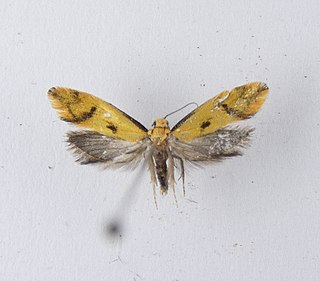
Tingena actinias is a species of moth in the family Oecophoridae. It is endemic to New Zealand and is found on the North and South Islands. The larvae of this species are leaf litter feeders. The preferred habitat of this species is shrubland and it has also been observed in gumland heaths and in beech forest.

Tingena maranta is a species of moth in the family Oecophoridae. It is endemic to New Zealand and is found in the lower South Island. Adults of this species are on the wing from October until January. This species prefers grass or low herb habitat. Unlike its close relatives it does not inhabit native forest.
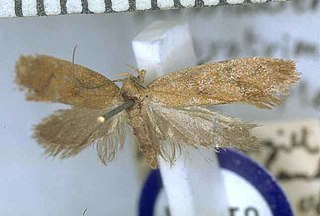
Tingena paratrimma is a species of moth in the family Oecophoridae. It is endemic to New Zealand and has been observed in the lower parts of the South Island. George Hudson regarded this species are uncommon. The adults of this species are on the wing from November to February.
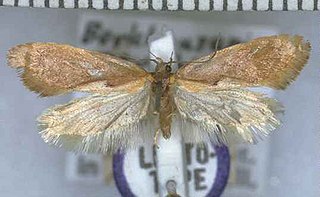
Tingena perichlora is a species of moth in the family Oecophoridae. It is endemic to New Zealand and has been observed in the southern parts of the South Island. This species appears to inhabit manuka scrub. Adults of this species are on the wing from October to January.

Tingena pharmactis is a species of moth in the family Oecophoridae. It is endemic to New Zealand and has been observed in the Nelson, Tasman and Wellington regions. The adults of this species are on the wing in December.

Tingena seclusa is a species of moth in the family Oecophoridae. It is endemic to New Zealand and has been observed in the Canterbury and Otago regions. The larvae of this species are litter leaf feeders and the adults of this species are on the wing from December to February.
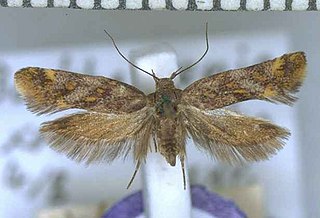
Tingena xanthomicta is a species of moth in the family Oecophoridae. It is endemic to New Zealand and has been found in both the North and South Islands. This species inhabits native scrub on hillsides and appears to be attracted to Coprosma areolata. Adults are on the wing from November until February.
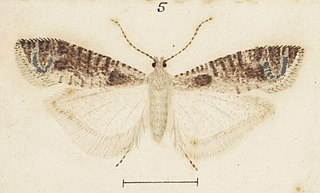
Holocola dolopaea is a species of moth in the family Tortricidae. It was first described in 1905 by Edward Meyrick. The species is endemic to New Zealand and has been observed in Whangārei, Hawkes Bay, Wellington and Christchurch. This species inhabits native forest or scrub glades. Adults are on the wing from September to December and are attracted to black light. This species is regarded as being rare.

Atomotricha exsomnis is a moth in the family Oecophoridae. It was first described by Edward Meyrick in 1913. It is endemic to New Zealand and can be found in both the North and South Islands. Adults are on the wing from November until January.

Atomotricha isogama is a moth in the family Oecophoridae. It was first described by Edward Meyrick in 1909. This species is endemic to New Zealand and has been observed in the North and South Islands. Larvae are leaf litter feeders and have been recorded as emerging in the New Zealand spring. Adults have been observed on the wing from July to January.

Orthenches chartularia is a moth of the family Plutellidae first described by Edward Meyrick in 1924. It is endemic to New Zealand and can be found in the North and South Islands. This species inhabits open grassy areas in native subalpine forest. Adults are on the wing in January and February.

Scythris epistrota is a species of moth in the family Scythrididae first described by Edward Meyrick in 1889. It is endemic to New Zealand and has been observed in the South Island. The larvae have been found on species of New Zealand broom and they pupate within an irregularly shaped, dense, silken cocoon. Adults are day flying and are on the wing from November until February.






















